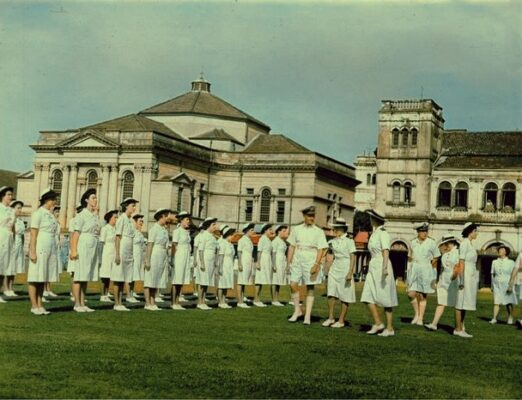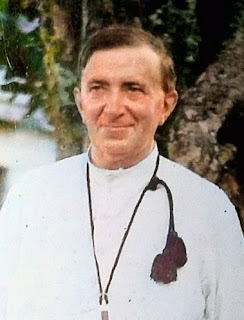ST. JOSEPH’S COLLEGE DURING WORLD WAR II – PART 2-By Avishka Mario Senewiratne

Source:ST. JOSEPH’S COLLEGE DURING WORLD WAR II
The British occupy the College
Given the extraordinary circumstances the country was facing due to the tense Japanese intervention during World War II, we discussed in the first segment that St. Joseph’s College had to be given over to the British so that they could station their Royal Navy in the school premises. It was they who occupied the College during 1942-1946. Part 1 of this series gave a glimpse of how the College functioned in exile at distant branches in Borella, Homagama, Kelaniya and Gampaha.
Therefore, discussing what the College ‘premises’ went through during this time is equally important. Young ladies (Wrens) from the lands of our colonists, who had joined the British Royal Navy, had to come to Ceylon, one of their best-known colonies, at the height of the worst war in history. Tensions in Maradana, where the College was located, were not ‘small’ by any means. This was because the Japanese had attacked Colombo, and the Maradana Railway Station was significantly damaged. Not much is known about what happened to the College during the years in question, yet the writer attempts to compile an account based on limited sources and rare photographs.
Who were these Wrens?

The Women’s Royal Navy Service popularly and more officially known as the Wrens were the women’s branch of the British Royal Navy. They were first formed during WWI in 1917 and disbanded in 1919, only to be revived in 1939, during the start of WWII. The Wrens mainly consisted of cooks, clerks, wireless telegraphists, electricians, air mechanics, radar plotters, and code breakers. The witty and popular slogan used to recruit Wrens in WWII was ‘Join the Wrens and free a man for the Fleet’. The Wrens were stationed in many of the Colonies the British had. Ceylon was one of them. Due to the spacious buildings and free space, St. Joseph’s College seemed ideal to station these young women. Obviously, the gentleman had to give better quarters to the opposite sex!Undoubtedly, the College lost some of its infrastructure during these years. Books in the library and archived documents seemed to have gone missing. This was once said to me by a senior Josephian. The College did not have the privilege to inquire into these matters. On the other hand, the British stationed in the College built several long rooms and other cabins. The purpose was not an easy one. Some of these wrens had the decisive role in code-breaking. They had to intercept radio messages from their rival Japanese and decode them to reveal secret information. These wrens were no amateurs at the task. One of them, Flora Crossley had trained in code-breaking at Bletchley Park, where Alan Turing operated his Bombe, which deciphered the German Enigma, saving millions of lives. One could catch a glimpse of code-breaking by watching the 2014 motion picture, The Imitation Game
Admiral Somerville celebrates his birthday at St. Joseph’s
 |
| Admiral Somerville |
Sir James Somerville (1882-1949) was the Commander in Chief of the British Eastern Fleet. Following the fall of Singapore, he transferred his fleet to Kenya and Trincomalee, Ceylon. It was under his rule that the Royal Navy faced a significant loss during the 1942 Easter Sunday raid. However, with reinforcements, he led an offensive strike on the Japanese-controlled Dutch East Indies in the spring of 1944. This earned him much respect from the Allied forces. He visited Colombo that same time. On July 17, 1944 as Somerville turned 62, he decided to have his birthday inspection at St. Joseph’s College, Colombo 10. This led the way for the capturing of some profoundly valuable photographs of the Wrens in the College and of course Somerville being honoured. The Imperial War Museum has safely archived these images.


The tragic end of a glorious life
 |
|
Fr. Maurice Le Goc OMI (1881-1945) |
The College was hardly open to anyone outside. The Rector, staff and students had to patiently wait for the war to end and see the Royal Navy leave St. Joseph’s. However, the British bent their rules on one occasion. This was to host the funeral of one of Ceylon’s most loved priests. On March 16, 1945, Fr. Maurice Le Goc was teaching at St. Bernard’s Seminary, Borella and excused his students that he had to leave early to celebrate a Benediction Service at St. Bridget’s Convent. A few minutes later, the unthinkable became a reality. His vehicle had collided with an Auxiliary Fire Service Tender at Ward Place junction, killing him almost instantaneously. The whole of Ceylon mourned for the untimely loss of a priest, who had contributed immensely to the causes of education, agriculture, botany, theology, astronomy and interreligious harmony in Ceylon. The British too mourned his loss and invited the Church to host his funeral in the very Chapel he built in St. Joseph’s College. So great was the gathering at his requiem mass that not even 1/3 of the crowd could n be contained in the large Chapel. The rest had to remain outside. His funeral procession was one of the largest, Colombo had seen during the war years.
To be continued….
Part III will discuss the famous march of the Josephians from Borella to the College, when the British handed it over to the students, less than a month before the 50th anniversary of the establishment of St. Joseph’s.








